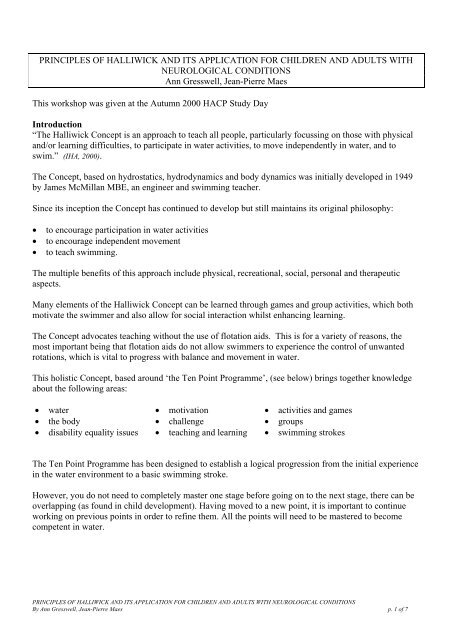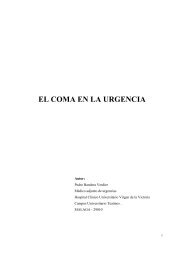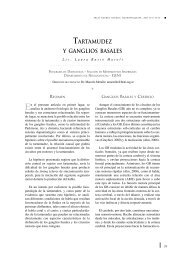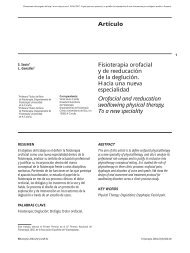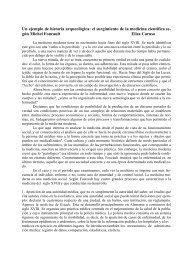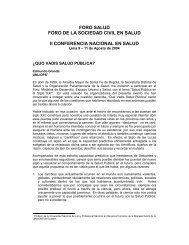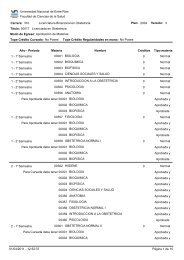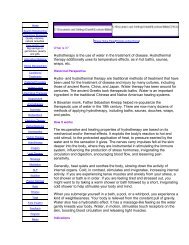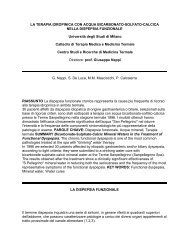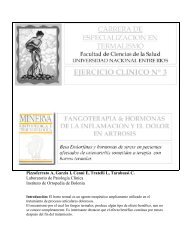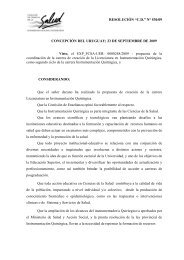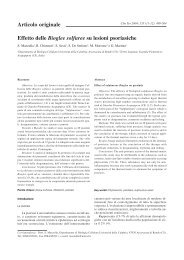Principles of Halliwick and its application for children ... - Halliwick AST
Principles of Halliwick and its application for children ... - Halliwick AST
Principles of Halliwick and its application for children ... - Halliwick AST
You also want an ePaper? Increase the reach of your titles
YUMPU automatically turns print PDFs into web optimized ePapers that Google loves.
PRINCIPLES OF HALLIWICK AND ITS APPLICATION FOR CHILDREN AND ADULTS WITH<br />
NEUROLOGICAL CONDITIONS<br />
Ann Gresswell, Jean-Pierre Maes<br />
This workshop was given at the Autumn 2000 HACP Study Day<br />
Introduction<br />
“The <strong>Halliwick</strong> Concept is an approach to teach all people, particularly focussing on those with physical<br />
<strong>and</strong>/or learning difficulties, to participate in water activities, to move independently in water, <strong>and</strong> to<br />
swim.” (IHA, 2000).<br />
The Concept, based on hydrostatics, hydrodynamics <strong>and</strong> body dynamics was initially developed in 1949<br />
by James McMillan MBE, an engineer <strong>and</strong> swimming teacher.<br />
Since <strong>its</strong> inception the Concept has continued to develop but still maintains <strong>its</strong> original philosophy:<br />
• to encourage participation in water activities<br />
• to encourage independent movement<br />
• to teach swimming.<br />
The multiple benef<strong>its</strong> <strong>of</strong> this approach include physical, recreational, social, personal <strong>and</strong> therapeutic<br />
aspects.<br />
Many elements <strong>of</strong> the <strong>Halliwick</strong> Concept can be learned through games <strong>and</strong> group activities, which both<br />
motivate the swimmer <strong>and</strong> also allow <strong>for</strong> social interaction whilst enhancing learning.<br />
The Concept advocates teaching without the use <strong>of</strong> flotation aids. This is <strong>for</strong> a variety <strong>of</strong> reasons, the<br />
most important being that flotation aids do not allow swimmers to experience the control <strong>of</strong> unwanted<br />
rotations, which is vital to progress with balance <strong>and</strong> movement in water.<br />
This holistic Concept, based around ‘the Ten Point Programme’, (see below) brings together knowledge<br />
about the following areas:<br />
• water<br />
• the body<br />
• disability equality issues<br />
• motivation<br />
• challenge<br />
• teaching <strong>and</strong> learning<br />
• activities <strong>and</strong> games<br />
• groups<br />
• swimming strokes<br />
The Ten Point Programme has been designed to establish a logical progression from the initial experience<br />
in the water environment to a basic swimming stroke.<br />
However, you do not need to completely master one stage be<strong>for</strong>e going on to the next stage, there can be<br />
overlapping (as found in child development). Having moved to a new point, it is important to continue<br />
working on previous points in order to refine them. All the points will need to be mastered to become<br />
competent in water.<br />
PRINCIPLES OF HALLIWICK AND ITS APPLICATION FOR CHILDREN AND ADULTS WITH NEUROLOGICAL CONDITIONS<br />
By Ann Gresswell, Jean-Pierre Maes p. 1 <strong>of</strong> 7
The Ten Point Programme<br />
Point<br />
1<br />
Point<br />
2<br />
Mental Adjustment<br />
Disengagement<br />
Being able to respond appropriately to a different<br />
environment, situation or task. The learning <strong>of</strong> breath control<br />
is an important aspect <strong>of</strong> this work. (IHA, 2000)<br />
One such example is adjusting to moving in water compared<br />
to moving on the side <strong>of</strong> the pool<br />
An ongoing process throughout the learning by which the<br />
swimmer becomes physically <strong>and</strong> mentally independent. (IHA,<br />
2000)<br />
Point<br />
3<br />
Point<br />
4<br />
Transversal<br />
Rotation Control<br />
(<strong>for</strong>mally Vertical<br />
Rotation)<br />
Sagittal Rotation<br />
Control<br />
The ability to control any rotation made about a frontotransversal<br />
axis. (IHA, 2000)<br />
The ability to control any rotation made about a sagittotransversal<br />
(anterior/posterior) axis. (IHA, 2000)<br />
Point<br />
5<br />
Point<br />
6<br />
Longitudinal<br />
Rotation Control<br />
(<strong>for</strong>mally Lateral<br />
Rotation)<br />
Combined Rotation<br />
Control<br />
The ability to control any rotation made about a sagitto-frontal<br />
(longitudinal) axis. (IHA, 2000)<br />
The ability to control any combination <strong>of</strong> rotations. (IHA, 2000)<br />
Point<br />
7<br />
Point<br />
8<br />
Point<br />
9<br />
Point<br />
10<br />
Upthrust<br />
Balance in Stillness<br />
Turbulent Gliding<br />
Simple Progression<br />
<strong>and</strong> Basic<br />
Swimming<br />
Movement<br />
Trusting the water will support you. Sometimes called ‘mental<br />
inversion’ (because the swimmer must invert their thinking<br />
<strong>and</strong> realise they will float <strong>and</strong> not sink). (IHA, 2000)<br />
Floating still <strong>and</strong> relaxed in the water. This is dependent on<br />
both mental <strong>and</strong> physical balance control. When balanced,<br />
other activities can be per<strong>for</strong>med more easily. (IHA, 2000)<br />
A floating swimmer is moved through the water, by an<br />
instructor, without any physical contact between them. The<br />
swimmer has to control unwanted rotations but makes no<br />
propulsive movement. (IHA, 2000)<br />
The development from simple propulsive movements made by<br />
the swimmer to a stroke which may be individual to each<br />
swimmer. (IHA, 2000)<br />
Illustrations: (Maes, 2000)<br />
The <strong>Halliwick</strong> Concept, through the Ten Point Programme, provides the three essential components <strong>for</strong><br />
motor learning:-<br />
Mental Adjustment - Balance Control - Movement<br />
PRINCIPLES OF HALLIWICK AND ITS APPLICATION FOR CHILDREN AND ADULTS WITH NEUROLOGICAL CONDITIONS<br />
By Ann Gresswell, Jean-Pierre Maes p. 2 <strong>of</strong> 7
Therapeutic Application <strong>of</strong> the <strong>Halliwick</strong> Concept<br />
As mentioned, the Concept has an holistic approach. One <strong>of</strong> <strong>its</strong> dimensions is therapeutic.<br />
The use <strong>of</strong> <strong>Halliwick</strong> as a therapeutic tool could be an essential or a secondary part <strong>of</strong> a therapy<br />
programme.<br />
Different therapists may find various useful <strong>application</strong>s <strong>of</strong> the <strong>Halliwick</strong> Concept according to their<br />
specific area <strong>of</strong> intervention (<strong>for</strong> example physiotherapist, occupational therapist, speech <strong>and</strong> language<br />
therapist …)<br />
RECREATION<br />
PERSONAL<br />
HALLIWICK<br />
SOCIAL<br />
THERAPEUTIC<br />
TOOL<br />
SWIMMING<br />
OR<br />
WATER<br />
ACTIVITIES<br />
MEDICINE /<br />
DRUGS<br />
HORSE<br />
RIDING<br />
Client / Patient<br />
“CLASSIC”<br />
TECHNIQUES<br />
……<br />
Illustrations: (Maes, 2000)<br />
PRINCIPLES OF HALLIWICK AND ITS APPLICATION FOR CHILDREN AND ADULTS WITH NEUROLOGICAL CONDITIONS<br />
By Ann Gresswell, Jean-Pierre Maes p. 3 <strong>of</strong> 7
Linking the Ten Point Programme to Therapy<br />
This section looks at the Ten Point Programme in relation to therapy. For each point to be mastered<br />
there are an infinite number <strong>of</strong> games <strong>and</strong> activities that can be practised. Here, having a lot <strong>of</strong> creativity<br />
helps!<br />
Some activities will suit your therapeutic interest more than others will; some activities can, <strong>of</strong> course, be<br />
adapted so that they fulfil the condition <strong>for</strong> your client to make progress.<br />
Each activity <strong>for</strong> a particular point can be analysed into individual components<br />
POINT 3 : Transversal Rotation<br />
This activity can be broken down in order to specifically address one <strong>of</strong> the following:<br />
SENSORY MOTOR COGNITION<br />
/PERCEPTION<br />
• Visual tracking • coordination <strong>for</strong> • preventing a startle<br />
reaching out : when in a supine<br />
• Integrate vestibular extending arms position<br />
input <strong>for</strong> balance with trunk flexion<br />
•<br />
•<br />
•<br />
• promote stability in<br />
the vertical through<br />
better abdominal<br />
activity<br />
•<br />
• <strong>for</strong> the client to<br />
realise that he/she<br />
has to participate in<br />
their own safety<br />
•<br />
OTHER<br />
• speech: blowing<br />
bubbles allowing<br />
<strong>for</strong> better control <strong>of</strong><br />
breathing<br />
•<br />
•<br />
•<br />
•<br />
Illustrations: (Maes, 2000)<br />
In the example below we look at the hypothetical case <strong>of</strong> a child with Cerebral Palsy, who has feeding<br />
difficulties due to hypersensitivity around the oral area. Within the activities chosen <strong>for</strong> Point 1, Mental<br />
Adjustment, we would place emphasis on tolerating water running over <strong>and</strong> splashing in the face within a<br />
playful <strong>and</strong> fun atmosphere.<br />
Equally, with a child with poor concentration, this activity could be used to gain the child’s attention so<br />
that he/she knows when you are going to pour water over his/her head again.<br />
Point<br />
1<br />
Mental<br />
Adjustment<br />
Learning to cope<br />
with the differences<br />
between dry <strong>and</strong> wet<br />
Functional Activity<br />
e.g. adjusting to having<br />
water running over the<br />
head <strong>and</strong> mouth while<br />
blowing bubbles…<br />
Illustrations: (Maes, 2000)<br />
Therapeutic Interest<br />
• sensory inputs<br />
• concentration<br />
• communication<br />
• ….<br />
•<br />
PRINCIPLES OF HALLIWICK AND ITS APPLICATION FOR CHILDREN AND ADULTS WITH NEUROLOGICAL CONDITIONS<br />
By Ann Gresswell, Jean-Pierre Maes p. 4 <strong>of</strong> 7
You could use the grid below as a working sheet, where you will identify the ‘therapeutic interest’ <strong>for</strong> a<br />
particular client, <strong>and</strong> then from this find out which functional activities would be most appropriate <strong>for</strong><br />
each <strong>of</strong> the 10 Points.<br />
Client’s name:<br />
Date:<br />
Point Mental Adjustment<br />
1<br />
Point<br />
2<br />
Point<br />
3<br />
Point<br />
4<br />
Point<br />
5<br />
Point<br />
6<br />
Point<br />
7<br />
Point<br />
8<br />
Point<br />
9<br />
Point<br />
10<br />
Disengagement<br />
Transversal<br />
Rotation Control<br />
(<strong>for</strong>mally Vertical<br />
Rotation)<br />
Sagittal Rotation<br />
Control<br />
Longitudinal<br />
Rotation Control<br />
(<strong>for</strong>mally Lateral<br />
Rotation)<br />
Combined Rotation<br />
Control<br />
Upthrust<br />
Balance in Stillness<br />
Turbulent Gliding<br />
Simple Progression<br />
<strong>and</strong> Basic<br />
Swimming<br />
Movement<br />
Functional<br />
activity<br />
Illustrations: (Maes, 2000)<br />
Therapeutic interest<br />
……………………<br />
……………………<br />
……………………<br />
……………………<br />
……………………<br />
……………………<br />
……………………<br />
……………………<br />
……………………<br />
……………………<br />
……………………<br />
……………………<br />
……………………<br />
……………………<br />
……………………<br />
……………………<br />
……………………<br />
……………………<br />
……………………<br />
……………………<br />
……………………<br />
……………………<br />
……………………<br />
……………………<br />
……………………<br />
……………………<br />
……………………<br />
……………………<br />
……………………<br />
……………………<br />
……………………<br />
……………………<br />
……………………<br />
……………………<br />
……………………<br />
……………………<br />
……………………<br />
……………………<br />
……………………<br />
……………………<br />
PRINCIPLES OF HALLIWICK AND ITS APPLICATION FOR CHILDREN AND ADULTS WITH NEUROLOGICAL CONDITIONS<br />
By Ann Gresswell, Jean-Pierre Maes p. 5 <strong>of</strong> 7
Specific therapeutic advantages <strong>of</strong> working in water:<br />
• Because <strong>of</strong> the supporting effect <strong>of</strong> water, it is <strong>of</strong>ten possible to facilitate more distally, there<strong>for</strong>e<br />
allowing more opportunity <strong>for</strong> the client to be active proximally.<br />
• In water, the therapist can provide specific fixed points that cannot easily be used on l<strong>and</strong>. This can<br />
allow a client to organise their movement in a particular way (<strong>for</strong> example, when the client is in<br />
supine, giving resistance at the posterior <strong>and</strong> external side <strong>of</strong> the heel can be part <strong>of</strong> the process to<br />
initiate extension, abduction <strong>and</strong> external rotation <strong>of</strong> the hip).<br />
• The client has to develop internal stability in water, as they cannot use external support to compensate.<br />
• Because movement in water is slower, the client <strong>of</strong>ten has enough time to regain their balance with<br />
very little therapeutic intervention. This will contribute to the development <strong>of</strong> independence.<br />
• Because asymmetry <strong>and</strong> associated reactions induce unwanted rotations in water, the need to move<br />
differently becomes more obvious <strong>and</strong> gives purpose to maintain a better alignment.<br />
• Abduction, external rotation <strong>and</strong> extension <strong>of</strong> the limbs facilitate balance in supine in the water.<br />
Abduction, external rotation <strong>and</strong> extension are <strong>of</strong>ten patterns we try to promote in clients with typical<br />
patterns <strong>of</strong> hypertonia (<strong>for</strong> example adduction, internal rotation <strong>and</strong> flexion <strong>of</strong> the hips or shoulders)<br />
• Hypertonia is influenced by the ef<strong>for</strong>t to maintain balance <strong>and</strong> to move against gravity. Working in the<br />
water where the effect <strong>of</strong> gravity is different, <strong>of</strong>ten reduces the hypertonia. This can be a starting point<br />
to develop appropriate sensory-motor experiences.<br />
• Because there is less risk <strong>of</strong> hurting themselves or falling against a hard surface, fear could be reduced<br />
(as long as the client is mentally adjusted to water).<br />
• Because the water supports you without any fixed point, every distal (limb) activity will require<br />
appropriate proximal (trunk) adjustments.<br />
• It is <strong>of</strong>ten easier, once in the water, to h<strong>and</strong>le/mobilise large clients.<br />
• Newly acquired skills (on l<strong>and</strong>) can be practised, repeated <strong>and</strong> integrated in water (generalisation).<br />
• The learning <strong>of</strong> some activities can be initiated more easily in water <strong>and</strong> can then be further developed<br />
on l<strong>and</strong> (<strong>for</strong> example balance in st<strong>and</strong>ing, or learning to blow as a preparation <strong>for</strong> oral communication).<br />
• Working in the water can facilitate sensory/perceptual processing needed <strong>for</strong> more efficient coordination,<br />
special orientation <strong>and</strong> general underst<strong>and</strong>ing <strong>of</strong> the world.<br />
• Group work in the water promotes social skills, turn taking, communication <strong>and</strong> opportunities <strong>for</strong> play<br />
<strong>and</strong> competition.<br />
• Going to the swimming pool provides a number <strong>of</strong> activities be<strong>for</strong>e <strong>and</strong> after getting into the water.<br />
For example packing the swimming costume, the journey, undressing/dressing….<br />
• Working in the water can bring variety, challenge <strong>and</strong> motivation (<strong>for</strong> the client <strong>and</strong> sometimes <strong>for</strong> the<br />
therapist!), especially in long-term rehabilitation.<br />
Conclusion<br />
As therapists you know what you want to achieve! Using the <strong>Halliwick</strong> Concept can give you a guide or<br />
tool to enhance/implement your therapy/management programme.<br />
Water can be fun, exciting <strong>and</strong> calming <strong>and</strong> also allows freedom to move, to experience the body in a<br />
different way, to develop social contact… And it can be extremely motivating.<br />
In 1997, Margaret Reid Campion wrote: “The influence <strong>of</strong> the <strong>Halliwick</strong> Method [as it was then known]<br />
on water activity is marked. It has brought about refinements in hydrotherapy techniques, developed new<br />
means <strong>of</strong> exercise <strong>and</strong> shown that combined therapeutic <strong>and</strong> recreational programmes provide continual<br />
rehabilitation <strong>for</strong> all disabilities in both paediatric <strong>and</strong> adult fields allowing the maximum potential to be<br />
reached <strong>and</strong> the physical, psychological <strong>and</strong> social benef<strong>its</strong> to accrue…”<br />
PRINCIPLES OF HALLIWICK AND ITS APPLICATION FOR CHILDREN AND ADULTS WITH NEUROLOGICAL CONDITIONS<br />
By Ann Gresswell, Jean-Pierre Maes p. 6 <strong>of</strong> 7
IHA (2000) International <strong>Halliwick</strong> Association Paper: the <strong>Halliwick</strong> Concept<br />
Maes J-P (2000) Presentation <strong>for</strong> the HACP workshop Autumn 2000 - <strong>Principles</strong> <strong>of</strong> <strong>Halliwick</strong> <strong>and</strong> <strong>its</strong><br />
<strong>application</strong> <strong>for</strong> <strong>children</strong> <strong>and</strong> adults with neurological conditions<br />
All illustration in this article are from Maes J-P<br />
For further in<strong>for</strong>mation on the <strong>Halliwick</strong> Concept contact <strong>Halliwick</strong> <strong>AST</strong> c/o ADKC Centre, Wh<strong>its</strong>table<br />
House, Silchester Road, London W10 6SB<br />
The <strong>Halliwick</strong> <strong>AST</strong> web site is www.halliwick.org.uk<br />
The IHA web site is www.halliwick.org<br />
Ann Gresswell MCSP, BEd (Hons)<br />
Jean-Pierre Maes MCSP<br />
PRINCIPLES OF HALLIWICK AND ITS APPLICATION FOR CHILDREN AND ADULTS WITH NEUROLOGICAL CONDITIONS<br />
By Ann Gresswell, Jean-Pierre Maes p. 7 <strong>of</strong> 7


